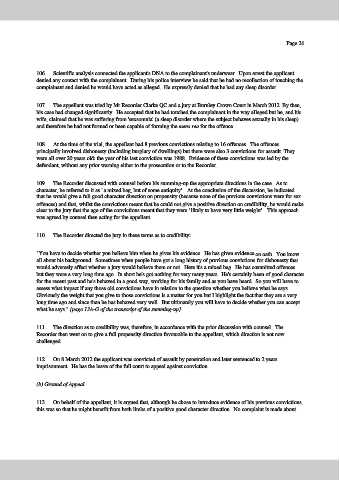Page 433 - Magistrates Conference 2019
P. 433
Page 26
106. Scientific analysis connected the applicant's DNA to the complainant's underwear. Upon arrest the applicant
denied any contact with the complainant. During his police interview he said that he had no recollection of touching the
complainant and denied he would have acted as alleged. He expressly denied that he had any sleep disorder.
107. The appellant was tried by Mr Recorder Clarke QC and a jury at Burnley Crown Court in March 2012. By then,
his case had changed significantly. He accepted that he had touched the complainant in the way alleged but he, and his
wife, claimed that he was suffering from 'sexsomnia' (a sleep disorder where the subject behaves sexually in his sleep)
and therefore he had not formed or been capable of forming the mens rea for the offence.
108. At the time of the trial, the appellant had 8 previous convictions relating to 16 offences. The offences
principally involved dishonesty (including burglary of dwellings) but there were also 3 convictions for assault. They
were all over 20 years old: the year of his last conviction was 1988. Evidence of these convictions was led by the
defendant, without any prior warning either to the prosecution or to the Recorder.
109. The Recorder discussed with counsel before his summing-up the appropriate directions in the case. As to
character, he referred to it as "a mixed bag, but of some antiquity". At the conclusion of the discussion, he indicated
that he would give a full good character direction on propensity (because none of the previous convictions were for sex
offences) and that, whilst the convictions meant that he could not give a positive direction on credibility, he would make
clear to the jury that the age of the convictions meant that they were "likely to have very little weight". This approach
was agreed by counsel then acting for the appellant.
110. The Recorder directed the jury in these terms as to credibility:
"You have to decide whether you believe him when he gives his evidence. He has given evidence on oath. You know
all about his background. Sometimes when people have got a long history of previous convictions for dishonesty that
would adversely affect whether a jury would believe them or not. Here it's a mixed bag. He has committed offences
but they were a very long time ago. In short he's got nothing for very many years. He's certainly been of good character
for the recent past and he's behaved in a good way, working for his family and as you have heard. So you will have to
assess what impact if any those old convictions have in relation to the question whether you believe what he says.
Obviously the weight that you give to those convictions is a matter for you but I highlight the fact that they are a very
long time ago and since then he has behaved very well. But ultimately you will have to decide whether you can accept
what he says." [page 13A-G of the transcript of the summing-up]
111. The direction as to credibility was, therefore, in accordance with the prior discussion with counsel. The
Recorder then went on to give a full propensity direction favourable to the appellant, which direction is not now
challenged.
112. On 8 March 2012 the applicant was convicted of assault by penetration and later sentenced to 2 years
imprisonment. He has the leave of the full court to appeal against conviction.
(b) Ground of Appeal
113. On behalf of the appellant, it is argued that, although he chose to introduce evidence of his previous convictions,
this was so that he might benefit from both limbs of a positive good character direction. No complaint is made about

